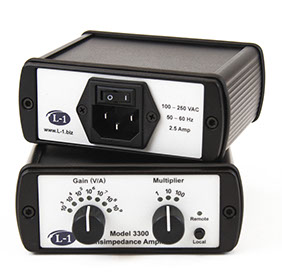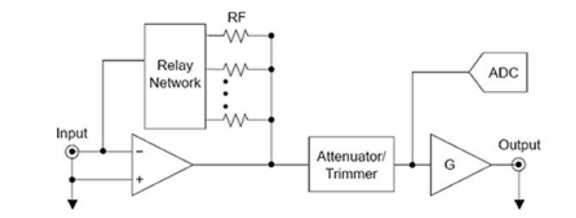PRODUCTS TRANSIMPEDANCE AMPLIFIER

The L-1 Standards Model 3300 trans-impedance amplifier is a precision electronic instrument designed to measure photocurrents to very low uncertainties for the most demanding optical metrology applications. The amplifier senses the current flowing into/out of its input, which is held at constant potential (virtual ground), and supplies a proportional analog potential at its output. There is an internal analog-to-digital convertor that can be used in-lieu of an external voltmeter to measure the output potential. The amplifier has 11 effective gains that may be set via front panel controls or remotely through a USB or Ethernet computer interface.
A block diagram of the amplifier is shown below:

There are 3 stages in the TIA: a current-to-voltage amplifier with selectable gains ranging from 103 [V/A] to 109 [V/A] by factors of 10, an electronically controlled trimming attenuator with a 0% to 1% range, and finally a voltage amplifier having gains of 1, 10 and 100 and full a full scale output of +/- 10 volts. The input is held at a virtual ground, with in a millivolt of its shield. Current flowing onto the input is forced through one of several feedback resistors using a low bias current op-amp. A network of relays select the feedback resistor. The internal analog-to-digital convertor samples the output voltage with 24 bits of resolution. The convertor supports several user selectable integration times and trigger modes. The available integration times include integer multiples of both 50 Hz and 60 Hz power line cycles. All critical components in the circuit are very stable and highly accurate. However, the trimming network was included so that all of the gains could be adjusted very close to their nominal values. The gains are set during factory calibration but may be adjusted following user calibration if desired. The trimming network resolution is approximately 20 ppm.
The computer interface is routed through a TIA power supply module. There are two module types. Model 3310 TIA Power Supply powers one TIA and supports USB communications with a Windows based computer, while Model 3311 TIA Quad Power Supply powers up to four TIAs and supports both USB and Ethernet communications. A 9-pin Mini DIN cable from a TIA power module routes both power and data to an amplifier. All data transfers are ASCII text based. To minimize the effects of ground loops, there is galvanic isolation between the TIA analog ground and the ground references of the USB, Ethernet, and line power cables.
The TIA can communicate with a Windows based computer via the USB port located on its power supply. An FTDI FT232RL USB2.0 UART converter located inside the power supply translates communications between the USB and the RS232 interface that connects the power supply to the TIA. Once installed on the host PC, the required USB driver creates a virtual COM port which emulates standard RS232 communications.
DOWNLOAD:

© 2017 L-1 Standards and Technology, Inc.
Corporate Information
- Welcome to L-1
- Contact L-1
- Gallery
- Terms & Conditions
- Careers
- Privacy Policy

